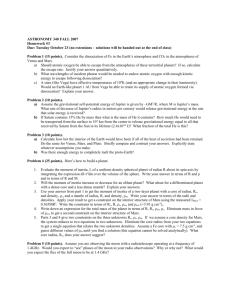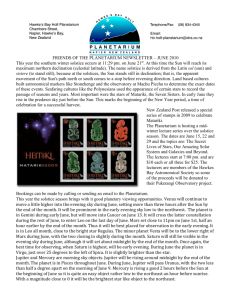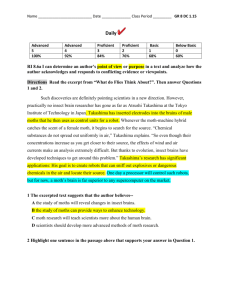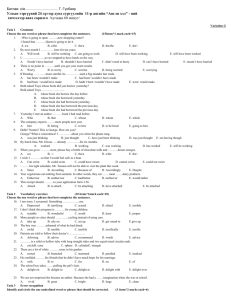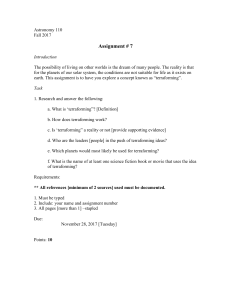The Planet Mars - FaradaySchools
advertisement
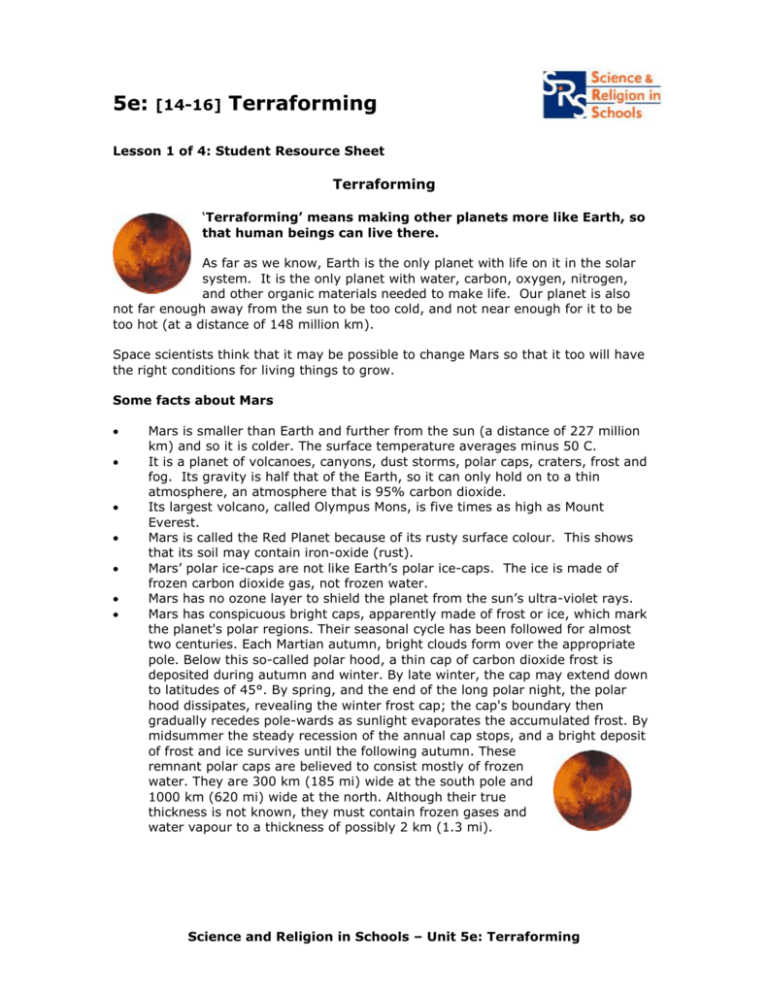
5e: [14-16] Terraforming Lesson 1 of 4: Student Resource Sheet Terraforming ‘Terraforming’ means making other planets more like Earth, so that human beings can live there. As far as we know, Earth is the only planet with life on it in the solar system. It is the only planet with water, carbon, oxygen, nitrogen, and other organic materials needed to make life. Our planet is also not far enough away from the sun to be too cold, and not near enough for it to be too hot (at a distance of 148 million km). Space scientists think that it may be possible to change Mars so that it too will have the right conditions for living things to grow. Some facts about Mars Mars is smaller than Earth and further from the sun (a distance of 227 million km) and so it is colder. The surface temperature averages minus 50 C. It is a planet of volcanoes, canyons, dust storms, polar caps, craters, frost and fog. Its gravity is half that of the Earth, so it can only hold on to a thin atmosphere, an atmosphere that is 95% carbon dioxide. Its largest volcano, called Olympus Mons, is five times as high as Mount Everest. Mars is called the Red Planet because of its rusty surface colour. This shows that its soil may contain iron-oxide (rust). Mars’ polar ice-caps are not like Earth’s polar ice-caps. The ice is made of frozen carbon dioxide gas, not frozen water. Mars has no ozone layer to shield the planet from the sun’s ultra-violet rays. Mars has conspicuous bright caps, apparently made of frost or ice, which mark the planet's polar regions. Their seasonal cycle has been followed for almost two centuries. Each Martian autumn, bright clouds form over the appropriate pole. Below this so-called polar hood, a thin cap of carbon dioxide frost is deposited during autumn and winter. By late winter, the cap may extend down to latitudes of 45°. By spring, and the end of the long polar night, the polar hood dissipates, revealing the winter frost cap; the cap's boundary then gradually recedes pole-wards as sunlight evaporates the accumulated frost. By midsummer the steady recession of the annual cap stops, and a bright deposit of frost and ice survives until the following autumn. These remnant polar caps are believed to consist mostly of frozen water. They are 300 km (185 mi) wide at the south pole and 1000 km (620 mi) wide at the north. Although their true thickness is not known, they must contain frozen gases and water vapour to a thickness of possibly 2 km (1.3 mi). Science and Religion in Schools – Unit 5e: Terraforming New theories As ever better images are relayed back to earth, new information is constantly being processed by NASA (The North American Space Agency). The latest images show dark streaks on crater and valley walls which could indicate that ice deposits under the surface of Mars may melt sometimes and flow across the surface. If this is so, then there might be a chance of finding living organisms. Change Mars to a new Earth? Sounds like science fiction? The new Mars would first of all be suitable only for certain plants, tiny organisms and bacteria - rather like the Earth of millions of years ago - but one day there could be seas and rivers flowing on the Red Planet, forests and cities. How might this be done? First, the planet would need to be warmed up. One way could be to put huge satellites with mirrors in orbit around Mars to reflect sunlight and melt the polar ice-caps. Another idea is to release the carbon dioxide in the soil and polar ice caps to create a ‘greenhouse effect’ which would make a warmer atmosphere containing oxygen. Some space scientists talk of finding asteroids made of ice in space and steering them towards Mars, where they would be melted down for water, or of exploding nuclear devices under the surface, to release underground water supplies. First steps? NASA has been sending out probes to Mars for a long time. It now hopes to have humans landing on Mars by 2020. Lots of people support terraforming After all, human beings have always wanted to explore and colonise new places. And who knows? – if a giant asteroid hit the Earth one day, we might be very glad of another planet to go to…. But some people are against terraforming. They think we should not interfere with other planets. They query whether it would be morally right to spend such huge amounts of money on space travel and on terraforming Mars when there are so many people in dire need on our own planet. Should we not rather try to get our own planet sorted before we mess up another one? And what if, in the distant future, the people on the two planets fell out? Then we could have a real-life Star Wars on our hands. Science and Religion in Schools – Unit 5e: Terraforming



